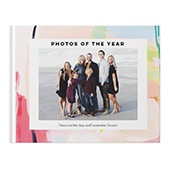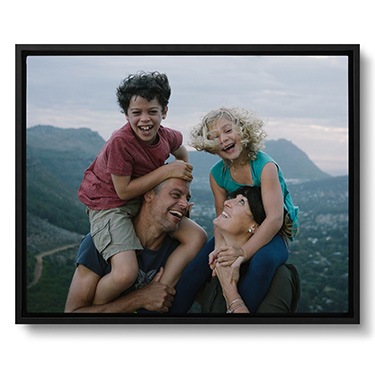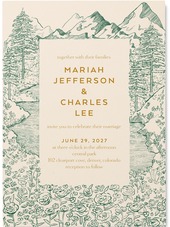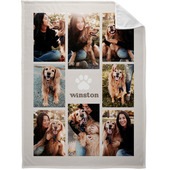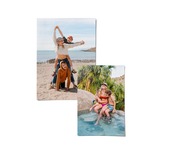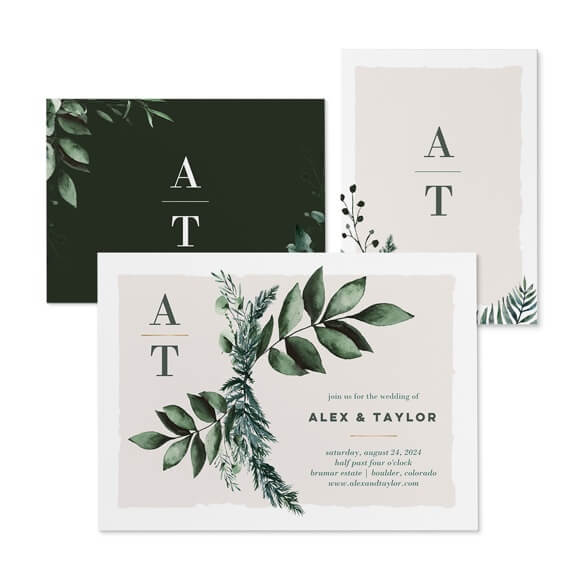Design Wedding Cards
Make invites and cards for your special day
- Wedding Invitation Shapes & Sizes
- Themes for Wedding Invitations
- Wedding Invitation Fonts
- Invite Paper Types
- Invitation Additions
- Wedding Invitation Cost
- Common Questions About Choosing Your Wedding Invitations
Wedding Invitation Shapes & Sizes
It’s important to pick the right shape and size of invitation for your wedding well before you make it to the mailbox. Different sized and shaped cards not only differ in postage costs, but they also change the overall look and feel of your wedding stationary. We’ve broken down the best wedding invitation ideas for the different shapes and sizes that Shutterfly has to offer.
- Tri Fold: Tri Fold invitations fold into thirds, accordion style. These styles often cost more than the standard invitation but adds a touch of elegance to any wedding invitation.
- Gate Fold: The two front folded halves open up to reveal the inside message in a gatefold. This style also often costs more than the standard invitation and adds more space for you to add more details about your wedding.
- Flat: A flat invitation is the standard, traditional style. There are no folds on the card, and therefore no additional costs.
- Square: Square invitations have the basic ninety degree angles for corners, making them the standard shape for invitations.
- Bracket: A bracket, just as the name sounds, has bracketed sides along all four edges.
- Round: These cards are similar to the square shape, but with rounded corners.
- Ticket: A ticket style invitation has inverted rounded corners, similar to an old fashioned ticket.
- Scalloped: Scalloped edges appear like a series of repeating curves across every edge of an invitation.
- Landscape vs. Portrait Orientation: Landscape orientation refers to the card printed with the top and bottom edges as the longest sides and the right and left edges as the shorter sides. A portrait orientation is the opposite.
Standard Size Wedding Invitations
The standard sizes for wedding invitations include the following four options. Note: the cost for a standard one ounce First-Class mail stamp is $0.55, however that price increases if the letter is differently shaped or heavier.- 5 x 7 inches: The most common wedding invitation size.
- 4 x 8 inches: A less common wedding invite size but still offers an interesting touch.
- 6 x 8 inches: Slightly larger than the traditional wedding card size, it gives a touch of glam with the additional space.

Themes for Wedding Invitations
The following themes are popular choices among many modern brides. From simple floral elements to an elegant vintage design, these styles can be easily applied to most wedding stationary. These wedding invitation ideas will set the stage for what your guests will expect for your wedding day.
- Rustic/Country: Elements include wooden patterns and burlap or barn accents.
- Vintage: Vintage styles play on design elements of an older era, such as an art deco style.
- Elegant: There’s many different types of elegant invitations. However, these styles typically focus on simplicity with a few special design elements.
- Simple: Simple invitations focus less on design elements and more on the clarity of the message. They may also be called minimalistic.
- Traditional/Classic/Formal: Traditional wedding invitations focus more on the wording and a simple, yet thematic design.
- Floral: Floral invitations feature plenty of flowers and other nature inspired design elements.
- Modern: For couples who choose modern wedding invitations, they can expect simple style typography and unique artistic elements.
- Tropical: These elements include flowers from the tropics and palm trees. Tropical invitations are especially perfect for destination weddings.
- Seasonal: Couples can also choose invitations stylized for fall, winter, spring, or summer based on color schemes and other natural elements.
Popular Colors for Wedding Invites
The right colors for your wedding invitations largely depends on the theme and style of your overall wedding. Additionally, seasonality plays a key role in color consideration for wedding invitations. Make sure to visit our resource on wedding color combinations for more help and wedding invitation ideas on how to pick the right color scheme for your wedding as well as color samples.
Wedding Invitation Fonts
Fonts, or typeface, describe the style of letters or characters of an invitation. Wedding invitation fonts often include a combination of a sans serif, serif, script, or other unique typeface. Choosing what type of font works best for your invitations largely depends on your invitation theme and style. To help, we’ve broken down the four main typeface styles for you below:- Serif: A serif is a small line attached to the end of a letter or symbol within a family of fonts. A common example of a serif font family is Times New Roman. This font is a popular choice for classic wedding invitations.
- Sans Serif: A sans serif is the opposite of a serif in that it lacks the smaller strokes attached to the letters. Helvetica is one of the most popular sans serif fonts available.
- Script: Scripts fonts aim to mimic the fluid strokes in handwriting. Thanks to the elegance of the typeface, many script fonts are common in wedding invitations. One of the most popular wedding script fonts is the condensed, calligraphic script font called windsong.
- Unique Fonts: Anything outside of the three categories above would be considered a unique font. For example, “Paper Font,” a popular wedding invitation typeface, was created by a designer who cut the letters from paper before digitizing them.

Invite Paper Types
The paper type or material you choose for your wedding invitations is important because this dictates the look and feel of the entire invitation. Choose a paper type that works for your wedding theme, but that also keeps you within your budget. Looking to get a sense of the different textures and designs of wedding invitations? Make sure to order our wedding invitation samples, at no cost to you. Popular wedding invitation materials include:- Cotton Fiber: A relatively expensive card material which is often chosen for its compatibility with a letterpress.
- Felt Cardstock: This paper is thicker than the average cardstock.
- Matte: This paper type looks clean and crisp, which makes it a common standard for online brands.
- Glossy: Glossy is a similar paper type to matte, with the addition of a glossy shine. It’s also a popular choice.
- Parchment: Parchment is a very common pick thanks to its affordability.
- Vellum: This see-through additional material is great for layering on top on a wedding invitation for a more luxurious result.
- Glassine: Glassine is a similar, but waxier paper type to Vellum.
- Handmade paper: Handmade paper is environmentally friendly and relatively affordable.
- Recycled Paper: Similar to the handmade paper, but it uses organic recycled materials and plants.
- Linen: A quality paper type that won’t break the bank.

Invitation Additions
These smaller additions help set your invitations apart from the rest. Just adding one or two of these wedding invitation ideas can elevate your cards’ look and feel and get your guests excited for the wedding.- Foil: Foil stamped wedding invitations are becoming more and more popular. The foil adds a nice element of texture and shine to an invitation.
- Envelopes (Inner and Liner): Inner envelopes or envelope liners are a great way to create a more luxurious invitation experience. For help customizing your envelopes or information on how to add an envelope liner, visit our addressing resource.
- Enclosure Cards: These types of cards include directions, itineraries and reception information. If you’d rather not add these to your envelope, make sure the information is easily available on your wedding website.
- RSVP Cards: RSVPs are essential, so it’s important to either include one in your wedding invitation, or to at least host your RSVP system on your website.
- Wax Seals: Some couples like to add a custom wax seal to their wedding invitations for a classic and elegant touch.
- Address Labels: Consider ordering custom address labels that match your stationary to complete your invitations.
- Lace: If you’re looking for an elegant way to make your invitations stand out, consider adding lace or ribbons. This often needs to be hand done, so consider the extra assembly time before purchasing.
- Customized Stamp: These customized stamps add a perfect final touch of personalization on your envelopes, and it lasts for years to come.
- Belly Ban: Belly bands not only hold your invitations together, but they make for a cute and classic finishing touch.

Wedding Invitation Cost
Wedding invitation packages can be very different, and therefore so can the pricing. A simple yet elegant package may cost $350, but more detailed cards with many add-ons for a large wedding can run as high as $10,000. It’s also important not to forget about shipping costs when budgeting for your invitations. Postage for a standard invitation costs $0.49 per card, but the price increases for different sizing and more weight. For a more complete breakdown of costs please visit our resources on how much do wedding invitations cost and our wedding budget calculator.Common Questions About Choosing Your Wedding Invitations
The following questions are commonly asked by couples when trying to decide on wedding invitations. From wedding invitation wording to knowing whether or not to include your registry, we’ve compiled a list of our answers below:What To Put On Wedding Invitations
The wedding invitation is the most important card in the envelope and tells your guests the who, what, when, and where of your wedding. Specifics to include are:- Host names
- The couple’s names
- Date and time
- Location name and address
- Dress code
- Other details and post ceremony plans
- Design elements

How To Fill Wedding Invitations
Wedding invitation mailing etiquette is an easily mastered art once you’ve had a little practice. To make sure you have all your invitation cards correctly placed, follow these steps:- Lay your wedding invitation card down on a flat surface with the words facing up.
- Place your reception card (if you have one), also with the wording side up, on top of the invite.
- Next, place your response or RSVP card on top of the reception card. Make sure it’s in the response envelope flap.
- Repeat for all other enclosure cards.
- If you have an inner envelope, place the invitation suite inside.
- Place the inner envelope inside the outer envelope. The front of the inner envelope should face you.
- Address the envelope and apply the correct postage.
When Should Wedding Invitations Be Mailed Out?
Wedding invitations are typically sent out between six and eight weeks before the wedding date. Save the dates should be sent out months earlier to give guests plenty of time to make plans for time off or vacation. It’s also important to give a reasonable deadline for the response card. And if you’re looking for more information you can visit our resource on when to send wedding invitations.What to Include on a Wedding RSVP Card
The most important things to include on a wedding RSVP or response card are as follows:- A blank line for guests to fill in their names.
- The RSVP reply due date. Use a date three to four weeks before the wedding date.
- The “will attend” line. Short and simple, this phrase can say anything along the lines of “Yes, I will attend your wedding.”
- The “unable to attend” line.
- A choice of entrées.

